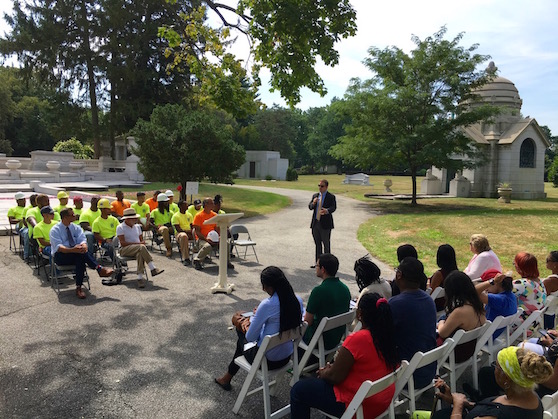
Sixteen students graduated from Woodlawn’s preservation training program on August 31, 2016, as family and friends gathered to celebrate. Photo by Micah Hauser.
Dakota Green spent his summer toiling beside the ghosts of old New York – power washing, chemically treating, and applying fresh mortar to the sarcophagi and mausoleums of the storied Woodlawn Cemetery in the northwest Bronx.
“To get into the stone cuts to make sure each little section is primped and perfect, that’s all me,” said Green, 22, dreadlocks spilling out from beneath a white hardhat and down the back of his neon t-shirt. He surveyed his handiwork in the 400-acre burial ground, whose roster of interred celebrities includes Herman Melville, Duke Ellington, and Elizabeth Cady Stanton. “I love it.”
Green was one of 16 young adults from the Bronx and Brooklyn to participate in this unique nine-week paid training program that teaches masonry restoration and historic preservation. Launched in 2015 as a joint effort between the Woodlawn Conservancy, the World Monuments Fund, and the International Masonry Institute, which is the educational arm of the International Union of Bricklayers and Allied Craftworkers, the program lays the groundwork for union membership among Black and Latino youth, a segment the union wants to recruit more actively, according to its most recent executive board report.
Some graduates also apply for masonry jobs with private contractors or suppliers. Either way, the program emphasizes finding a sustainable career over immediate employment. Many participants have bounced around low-wage, low-skill positions and are ready for a change.
“They’re just aching for a consistent job,” said Susan Olsen, Woodlawn’s director of historical services. “It’s fine to spend a summer at The Gap, but that doesn’t get them anywhere. It’s about getting 18 to 24-year-olds who are not college bound, or who are even going to college part-time, invested in a career that makes a livable wage in New York City.”
Two of the best students from this year’s class have accepted 19-month full-time apprenticeships at Woodlawn. The position pays $20 per hour, competitive with entry-level union jobs, and it comes with healthcare.
But it’s not only cemeteries that need restoration. The Landmarks Preservation Commission, the city agency responsible for protecting architecturally and historically significant buildings, has designated and protected over 35,000 properties throughout the five boroughs, and there aren’t enough trained preservationists to keep up with demand.
“It’s sort of been considered old man’s work,” said Olsen. “The idea being that when you can’t get up 50 stories with a bag of cement, you fix some terra cotta. We’re trying to get people trained in historic preservation crafts at the beginning of their career, rather than at the end.”
With more than 1,300 mausoleums and 150,000 monuments, many of which look more like Greek temples than traditional gravestones, Woodlawn is an ideal outdoor classroom.

The students carefully cleaned and restored the Tennessee marble and Milford granite of the massive Borden Monument (1904), a memorial to Matthew Borden, aka the “Calico King,” a textiles magnate and fixture of the New York upper crust at the turn of the 20th century. Photo by Micah Hauser.
“These monuments are like art pieces,” said resident craftsman Robert Cappiello, who trains the students. “Once you start working on them, you don’t want to stop. And there’s plenty to do – a whole team of people could work here for their entire careers and never finish.”
In addition to nine weeks of on-the-job experience, graduates receive Occupational Safety and Health Administration (OSHA) certification in suspended and support scaffolding, a requirement for many construction jobs.
“I was actually kicked off a construction site by an OSHA inspector right before I did this program,” said Green, who commutes from Flatbush to Woodlawn – the entire length of the Number 4 line – to get to work each day. “It was a point in my life where I was shooting back and forth between jobs, but these jobs weren’t really getting me anywhere. Now, I picked up a skill and a whole lot of experience, things I hope I’ll be using for years and years.”
Although many pursue masonry jobs straightaway, some graduates have decided to get college degrees. Schechem Scatt, 19, who completed the program last year and stayed on as an apprentice, works at the cemetery part-time and takes classes at the Culinary Institute of New York at Monroe College.
“I want to try to keep doing both,” said Scatt. “Somehow, someway, at the same time.”
Perhaps the two aren’t as incompatible as they seem.
“I guess working on mortar joints is no different than frosting a cake,” said Olsen. “We want people to have reverence and feeling for anyone working in the trades. Europeans revere them. Americans do not.”



